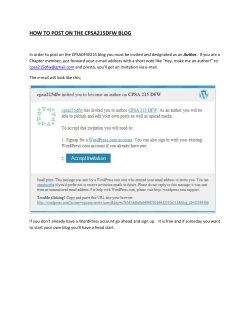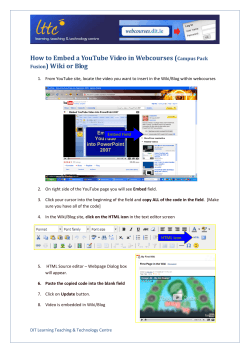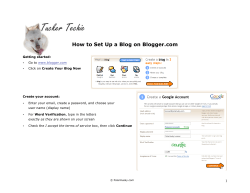
How to blog in 5 minutes
Dr Andrew Oliver: Learning Technology Development Unit & The Blended Learning Unit How to blog in 5 minutes First decide on what type of blog you require. There are three types of blog in StudyNet: Personal blog: your own blog area. You own it and only you can add entries. Can be private or made public to the rest of the university. Module blog: a group blog area. All members can create blog entries. Access is restricted to those associated with the module. StudyNet Groups blog: as with the module website group blog all group members can create blog entries. However access can include any member of the university (or be restricted). Dr Andrew Oliver: Learning Technology Development Unit & The Blended Learning Unit Your Personal blog What are they? ‘Blog’ is short for ‘web’ and log’ and is an extremely powerful learning tool. A blog allows you to add content which can be read by the rest of the university. You can also link your blog to those of other individuals and form communities of people focusing on shared goals and learning topics. Essentially you can use your blog to disseminate, share and discuss information relating to your teaching and research interests, your studies, university initiatives and topical issues. In other words it is up to you. What can they be used for? Staff might want to use their blogs for the following: Disseminating information to students and other staff. Supporting students on placement or new staff teaching at the university. Directing students to extend class topics by forming learning communities in which they read and comment on each others blog entries (including the tutors). This is used in the School of Education. Drafting, refining and collecting ideas together for research. Students may use the blogs for: Social interaction and finding people who have similar interests Reflecting on course content, careers (e.g. placement progress, used by Wets Herts College) and topical issues. This might be private or public. How do they work? Content is added by creating new entries which are listed in reverse chronological order. They are also stored and listed under the month in which they were posted. You can also group entries by assigning a keyword, such as a research area. The entries are then displayed by keyword category for users to explore. If you make your blog public (see below) readers can add comments to each entry. This is great for discussion. You can also link to other blogs and in doing create a community of like-minded individuals interested in the same issues. Private or public? By default the blog is set to private but you can enable the blog to be viewed by the rest of the university (see below for details). As of 2006 your blog cannot be viewed by external people. Dr Andrew Oliver: Learning Technology Development Unit & The Blended Learning Unit Where are they? Your blog is located in your StudyNet portal under the options on the left side menu. Setting your blog to public/private Log into StudyNet. The portal area opens by default. The blog option is listed option the left side menu. Scroll down and click on ‘Blog Settings’ (right side). Locate the ‘Privacy and Display Options’ heading. By default your blog is set to private. If you would you would like other UH members to read you blog select ‘Public’, scroll down and click on ‘Save’. To keep your blog private leave the setting to private. You can always make you public blog private again by accessing the Blog Settings. NOTE: the public option means that any member of the UH can read and comment on your blog entries, (see below for more on comments). This includes both staff and students. However you should not be concerned over abusive messages since all users of StudyNet are bound by terms of agreement. Creating your first blog entry Only the blog owner can create entries within the blog, the readers cannot, (but they can leave comments, see below). Click on ‘New Entry’ (top right). Type in a subject and add your comments. Use the buttons provided to add text formatting, website links etc. Assign your blog a keyword this will help you and your readers to group together related articles. You can assign more than one keyword so that the entry will be listed under a number of categories. Click on ‘Save’ and that is it – you have just created your first blog entry! Note the ‘Edit’ and ‘Comments’ buttons. Editing: allows you to modify the content of your blog. Only you can do this, no one else can. Comments: you can read any comments left by readers (if the blog has been made public). You can even add your own comments and have a discussion. You cannot edit the comments left by readers but you can remove them if you so wish. Similarly readers cannot create new entry on your blog, they can only comment on entries created by yourself, (group blogs allow all members of the group to create and comment on blog entries). Dr Andrew Oliver: Learning Technology Development Unit & The Blended Learning Unit Also you not have to have a blog in order to comment on another person’ blog. Delete: you can delete your blog entry by clicking on ‘Edit’ button and then clicking on ‘Delete’ (top right). Where can I read other people’s blogs? If other UH members have made their blog public then you can access them in ‘Blog Central’ via the ‘Social’ area. In StudyNet: click on ‘Social’ (top menu) locate the ‘Blog Central’ icon (centre screen) and use the facilities to search for blogs You can search by username, blog title, and category. Categories are based on blog entry keywords, for example if you select ‘podcast’ then all blogs with entries on podcasting will be listed (and so good for research and locating experts or policy makers in particular fields). How do I link my blog to other blogs? Linking your blog to other blogs creates a community of individuals with similar interests engaged in similar learning activities. Coupled with the ability to read and comment on each others blog entries the community is able to generate, extend and share knowledge. Linking to other StudyNet Blogs At the UH the School Education encourages students to link their blogs to create learning communities centred upon reflective practice and placement support. Locate the blog you wish to link to through using the search facility in Blog Central. Click on ‘Add blog to favourites’ (under the heading ‘About the user’) and follow the onscreen instructions. When you go to your blog and you will see the other persons’ blog listed under ‘Favourite blogs’. By linking to another person’s blog you are effectively saying ‘this person has something interesting to say, possibly in a related area’. Readers of your blog will now be provided with another blog which covers topics in a related area which is handy for research. Dr Andrew Oliver: Learning Technology Development Unit & The Blended Learning Unit Linking to other external Blogs You can also link to external blogs. This is useful for pointing your readers / peers / students to related blogs of interest. Go to the external blog you wish to link to and copy the URL / web address. In StudyNet, lo into your Portal Locate the ‘Favourites’ link and click on it Click on the ‘New Entry’ button. On the form that opens: o Enter the title of the blog in the Title box o Paste in the URL / web address in the ‘URL of resource’ box o Then select ‘Blog’ from the ‘Resource Category’ list* o Ignore the other sections and click ‘Save’ Go to your StudyNet. The external blog link will be listed under ‘Favourite Blogs’ (right side). *this part is important otherwise the link will not be viewable in your blog Please note: external blogs can also link to your blog but it should NOT be encouraged. This is because, although external users would be able to see the link to your StudyNet blog, they have to be a member of UH and have a StudyNet user account in order to access its contents. Dr Andrew Oliver: Learning Technology Development Unit & The Blended Learning Unit Module Blogs What are they? A module blog is similar to personal blog but anyone associated with the module can create a blog entry and comment on other blog entries. How do they work? New entries are posted and displayed chronologically in a similar fashion to personal blogs. Also, again as per personal blogs, blog entries are also archived under the month they were posted and can be tagged with keywords and stored under categories. The main difference is that the module blog is owned by the module which means that any member of the group can post a blog entry. For more detail on how blog entries are posted, edited, removed and commented on please refer to the Personal Blog section. How do I set it up? Go to the module and click on ‘Configure Website’ Select ‘Website Functionality’ Locate ‘Blog’ and select ‘On’ IMPORTANT: Locate ‘Student can add items’ and select ‘On’ Scroll down and click ‘Save’. The Blog will be listed in the left side menu. How do I create a module blog entry? Creating a blog entry is similar to that of the personal blog. To create a blog entry click on New Entry. In the boxes provided enter a subject and add text as appropriate. You can also attach files (which cannot be done in the Personal Blog). Finally tag the entry with a keyword. This stores the blog entry under a specific category and is useful for grouping together blog entries. Click on Save. Remember this is a module blog in which any member of the module can create a blog entry. Commenting on blog entries As per the personal blog each blog entry allows readers to add comments which is useful for extending the topic into a discussion. However only those individuals who can access the module will be able to read blogs and leave comments. Dr Andrew Oliver: Learning Technology Development Unit & The Blended Learning Unit Additional: Module Group Blogs You can also have blogs associated with the group work facilities. What can they be used for? Group blogs can be used for a group of people who are working on a common project, topic or theme. The main difference between group blogs and the module blog is that the group blogs can be private to a specific group of individuals. Specifically they are useful for: Facilitating mutual collaboration & knowledge sharing Providing a log of activity e.g. on projects in which each phase is captured as it happens rather than constructing a retrospective account. The group blogs have the same functionality as the module blog. However creating blogs entries and adding comments is confined only to group members. How do I set up a group blog? Go to the module and enable the group work options. To do this: o Click on ‘Configure website’ under ‘Website Manager’ (left menu) o Click on ‘Website Functionality’ o Scroll down and set ‘Group Work’ to ‘On’ and click ‘Save’. Now create the group. To do this: o Click on ‘Manage Groups’ under ‘Group Manager’ (left menu). o Under options click on ‘New Group’ o In the box provided give your group a name. o Under ‘Number of groups’ decide the number of groups you require. o Locate ‘Group work features enabled for this group’ and click on the ‘+’ box. You will see a list of the features selected for the group. The group blog has been checked by default, (a full description of the group options is beyond the scope of this guide, but it is worth noting that the group can have wiki functionality, called ‘pages’, if you wish). o Scroll down and click ‘Save’ You group will now be created. If you created more than one group then each group will have its own dedicated group blog. Who has access to the group blog? Membership is restricted to staff associated with the module and students registered as learning on the module. Using the group manager you can further restrict the group to include specific sets of students or create student or staff Dr Andrew Oliver: Learning Technology Development Unit & The Blended Learning Unit only groups. To do this you need to go to the Group Manager, locate your group and use the Assign Users facility. How can I view the group blog? Under ‘Group Manager’ click on View all Groups Locate the group and click on the group title Click on ‘Blog’ to list the blog entries Note older entries will be archived under month headings (right) Dr Andrew Oliver: Learning Technology Development Unit & The Blended Learning Unit StudyNet Group Blogs What are they? StudyNet group blogs are similar to those of the module website: They can be open to all staff and students across the university. You can control access so that only specific sections of the university have access or all members have access (23,000 people approx.). Unlike module group blogs which end when the module has ceased being taught the StudyNet group blogs will continue as long as they are being added to. So they can become a very rich resource. It is also worth noting that the groups also come with standard resource areas, file storage, project planners, forums and wikis. So potentially they can be very a powerful resource. What can they be used for and how do they work? StudyNet group blogs have the same look, feel and functionality as the group blogs on the website so for details have a look at the previous section (Module Website Group Blogs). Typical use is for providing supportive information to a readership, e.g. LIS BusiBlogs in which LIS consultants provide information for Business School staff and students. How do I set one up? In StudyNet click on Your Groups (top menu) Locate the option Go To StudyNet Groups (right side) and click on it Locate the option Create a group (right side) and click on it Read terms and conditions and click on create a new group. You will need to provide a name for you group together with a description of its purpose. Who has access to the group blog? Membership can be restricted according go the purpose of the group. When you set the group up you can have: a private group, for which users request access. a semi private group, for which users must register. a public group which allows anyone access without prior registration. Dr Andrew Oliver: Learning Technology Development Unit & The Blended Learning Unit Adding new members Once the group has been created you can use the group management facilities to add new staff or student members. In your group locate and click on Manage Group (left menu). Use the Add User (centre listed under Options) option to add new members How can I view the group blog? Go to Your Groups and click on the group title. Blogs is listed as an option on the left menu. Click on Blogs to view recent entries. Note older entries will be archived under month headings (right). How do I create a group blog entry? In terms of function creating a blog entry is similar to that of the personal blog. To create blog entry click on New Entry. In the boxes provided enter a subject and add text as appropriate. You can also attach files (which cannot be done in the Personal Blog). Finally tag the entry with a keyword. This stores the blog entry under a specific category and is useful for grouping together blog entries. For example you could choose a subject or use your name (good for group blogs). Click on Save. Remember this is a group blog in which any member of the group can create a blog entry. Note: although you can attach files there is a 10MB storage limit to the group blogs. Commenting on blog entries As per the personal blog each blog entry allows readers to add comments which is useful for extending the topic into a discussion. However only those individuals who can access the group will be able to read blogs and leave comments. Dr Andrew Oliver: Learning Technology Development Unit & The Blended Learning Unit Further information This document is part of a series which includes: How to: How to Blog in 5 minutes (Word) How to Wiki in 5 minutes (Word) How to create a Podcast in 5 minutes (Word) How to convert audio files to MP3 in 5 minutes (Word) How to use RSS in 5 minutes (Word) You need to know… You need to know about Podcasting (Slides) You need to know about Podcasting: a teaching and learning guide (Word) You need to know about Online Discussions: a teaching and learning guide (Word) You need to know about Blogs (Slides) You need to know about Wikis (Slides) You need to know about RSS (Slides) You need to know about Web 2.0 (Slides) You need to know about Computer Assessment (Slides) You need to know about Effective Question Design (Slides) You need to know about Electronic Voting Systems (Slides) Also available: Podcasting: audio talk on the benefits of podcasting (hi quality) CAA: using statistic analysis to design effective questions For copies please contact: Dr Andrew Oliver. LTDU, College Lane LRC (a.oliver@herts.ac.uk, ext. 4754).
© Copyright 2025









